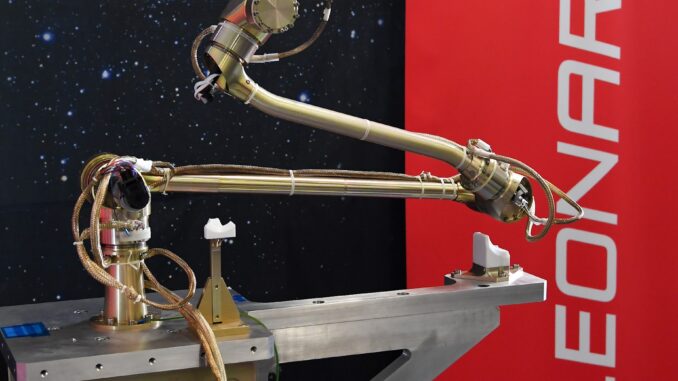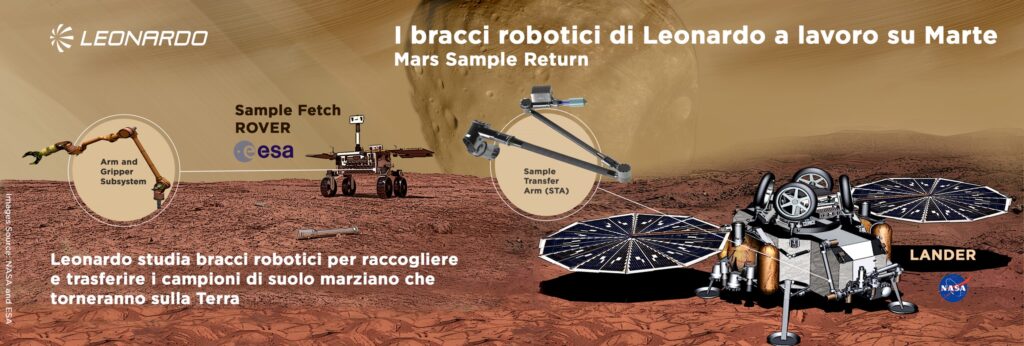
Mars robotic exploration is at the heart of the latest international space missions. Leonardo is involved in the study of cutting edge robotic systems which can contribute to the discovery of the Red Planet’s secrets. For the NASA “Mars Sample Return” campaign, in collaboration with the European Space Agency (ESA), Leonardo has been awarded a contract with Airbus for the advanced study phase (Advanced B2) of the ESA Sample Fetch Rover’s (SFR) robotic arm and has received financing from ESA to pursue the study of the Sample Transfer Arm (STA) for the NASA lander.
Leonardo, also thanks to the important contribution of the Italian Space Agency, is therefore involved in the study of two crucial elements for the 2026 mission of the Mars Sample Return campaign: the arm of the rover and that of the lander. For both, Leonardo is committed to design the respective robotic systems for the acquisition and manipulation of the samples.
The SFR industrial consortium is led by Airbus UK. The design of the SFR robotic arm, after an early phase of concept study and testing, is now entering into an advanced phase with the development of the first robotic arm prototype (breadboard) to show the high capabilities of the system. The arm is extendable up to about 110 cm, its control system features 6 degrees of freedom and is equipped with a gripper or end effector at its tip. NASA lander’s STA is a more complex arm, with 7 degrees of freedom that exceeds 200 cm of extension, and it is now beginning the development phase of the breadboard. Leonardo is leading the international industrial consortium in charge of the design of the control electronics, of the software and of the vision system.
The design of both SFR and STA robotic arms is based on the experience gained in the development of the Leonardo DELIAN and DEXARM models, which are still considered standards in the European space market. In addition, the Company has a strong knowledge of the space drilling sector, having developed drills for missions such as Rosetta, ExoMars and Luna-27.
For the MSR campaign, Leonardo will also contribute to the Earth Return Orbiter (ERO) through Thales Alenia Space (joint venture between Thales 67% and Leonardo 33%) which will be responsible for supplying the communication system allowing data transmission between Earth, ERO and Mars, designing the crucial Orbit Insertion Module, managing the Assembly Integration and Test (AIT) phase for the Proto-Flight model of the ERO spacecraft.
Mars Sample Return (MSR)
The joint ESA/NASA MSR campaign includes three missions that will be launched starting from 2020. These missions will work together to reach the ambitious goal of bringing back to Earth some samples of Mars soil by 2031.
The first NASA mission “Mars2020”, launched in July, will see the rover Perseverance drill down the soil and collect some samples of the Martian ground. Perseverance will seal the rock and soil samples in suitable tubes and will release them in strategic positions waiting to be collected by the following mission.
With departure planned in 2026, the “Sample Retrieval Lander” is the second mission of MSR. This mission consists in three elements: the NASA lander, the ESA Sample Fetch Rover, and the Mars Ascent Vehicle (MAV). Leonardo is involved in the study of the arms for the NASA lander and the ESA rover that will have different features and tasks. The rover, through the robotic arm, will search and collect the tubes with the samples and will take them to the NASA lander. Then, the NASA lander with its ESA arm will move the samples to the MAV that will launch them with a special capsule into the Martian orbit.
Finally, the third mission, the “Earth Return Orbiter” (ERO), will be scheduled in relation to its task of collecting the capsule in orbit and bringing them on Earth. Leonardo, through Thales Alenia Space, will be involved with the furniture of crucial elements of orbiter. Landing is planned in Utah (USA).









Be the first to comment